Here we will show why Inamon is so important for the insurance
company as well as the end customer, when we look at price
differentiation.
What is it?
Price differentiation is where you look at the risk you are
taking and setting the price accordingly. It is not a new thing, as
without it, the price would be the same for all cars and drivers,
and we all know that this is not the case.
Price differentiation rates on a large number of criteria
divided into two groups:
- Profile of the insured person and object, e.g. type of car, age
of driver, immobiliser, post code etc.
- Cover required, e.g. Comprehensive or Third party fire and
theft, Legal protection, Break down, Courtesy car etc.
A more granular example is a home policy where a customer may
have an option to be covered for Freezer Content. Those without a
freezer don't need that cover, and even if they do have a freezer,
they may not want the cover. The customer may want the cover, but
may want to decide how much it should cover. If you fill your
freezer with lobsters and fillet steaks, you need more cover than
if you just keep a few pizzas. You get the gist!
Many insurance companies offer free included cover of some kind.
It isn't free and often just a sign that they can't price
differentiate in their IT-systems.
Price differentiation can be seen in other industries such as
airlines, where some carriers charge for what you get, e.g. bags in
hull, food on board, priority boarding etc. Previously you would
pay for a service whether you wanted it or needed it.
The internet has created new opportunities for micro level
unbundling with computer based price calculations and where the
customer has the option of selecting exactly what is required, not
buying a "one size fits all" product.
Below is an illustration of the impact on the insurance company
when using price differentiation and just as importantly when not
using it.
|
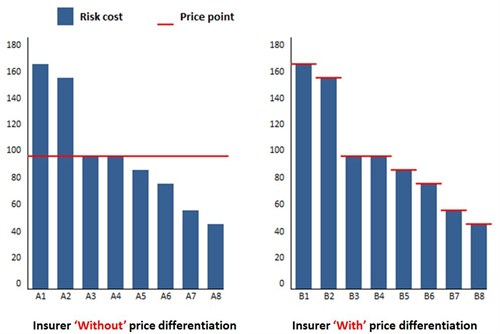
|
- Two insurance companies starts with the same portfolio mix
- One company charge the same price for all policies
- The other company charge according to the calculated risk
- We call them 'With' and
'Without'
|
|
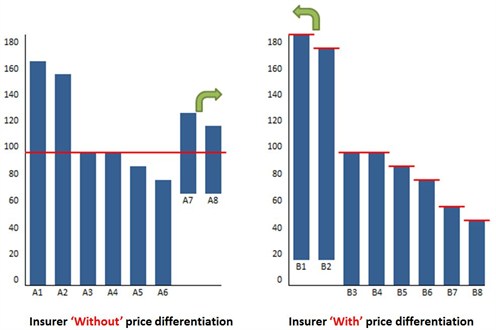
|
- Customers with policy A5, A6, A7 and A8 can get a better price
with 'With'
- Customers with policy B1 and B2 can get a better price with
'Without'
- A7, A8, B1 and B2 moves to the cheaper company
|
|
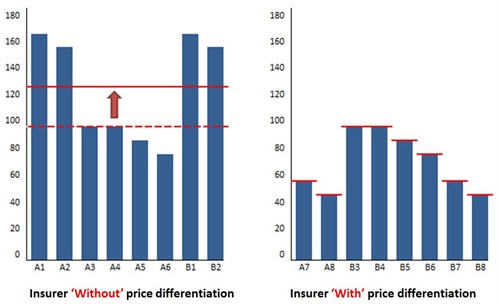
|
- 'Without' now have to
increase the price to remain profitable
- 'With' has lost some
revenue
|
|
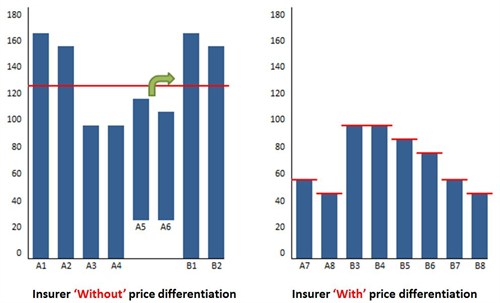
|
- Because of the price rise, more customers have had enough and
will move from 'Without' to
'With'
- No one wants to move to 'Without' anymore
|
|
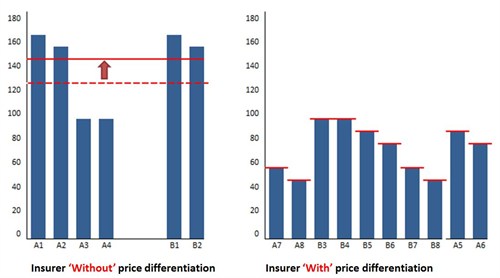
|
- 'Without' now has to
increase the price again causing even more customers to leave
- 'With' ends up with higher
revenue as well as higher profitability
|
From the illustration above we can draw the following
conclusions:
- Customers will migrate to the company with the lowest
price
- Customers with a low risk will move to insurance companies with
high price differentiation
- Customers with a high risk will move to insurance companies
with low price differentiation
- Insurance companies with high price differentiation will
attract the good risks
- Insurance companies with low price differentiation will attract
the bad risks
- Insurance companies with low price differentiation will be
threatened in the long run, as they continue to increase prices to
cover their highest risks.
- Insurance companies with high price differentiation will have
better profitability and can continue to win business.
- In other words, use price
differentiation and prosper or don't use it and get
punished.
How Inamon can help?
At initial sale it is of course important that the customer can
buy exactly the required cover, and Inamon is perfectly geared to
that. The more the customer can visualise of the selected cover,
e.g. via slide-selection, the quicker the customer will understand
the available cover range and remember what the policy covers in
the end.
To actively select the cover levels makes it much more
transparent than having to find the limits in the terms and
conditions.
If the customer is buying a "one size fits all" product, it is
not likely that any changes to circumstances will require changes
to the policy, but if the customer buys a tailor made product, it
is very likely that changes to circumstances will require changes
to the policy.
This is where the self-service facilities of Inamon are so
important. The more price differentiation is used for a product,
the more changes to the cover is required when circumstances
changes. The more changes to the policy required, the more sense it
makes for the insurance company and the customer to use
self-service.
Amendments via call centres are costly, but self-service is free
and a win/win situation for customers and insurance companies.
An example of a change is when the customer buys a specified
item on holiday, e.g. a watch, and may only be covered when the
item is registered on the policy. The customer will have access to
the account and can update the policy accordingly, there and
then.
Conclusion
There is an accelerating trend towards more precise pricing for
risk, based on increasingly detailed personal information and where
the customer is only charged according to the risk they
represent.
Price has always been an important differentiator in the mass
market, but the rise of aggregators has made comprehensive price
comparison easy.
With margins under severe pressure, accurate pricing for risk
represents the principal strategy whereby insurers can hold onto
market share without seeing their profitability diminish to a low
level.
IT systems are essential in this process and must satisfy the
business goals of enabling granular rating as well as easy
adjustment of cover and circumstances.
Inamon does this better than any other solution.